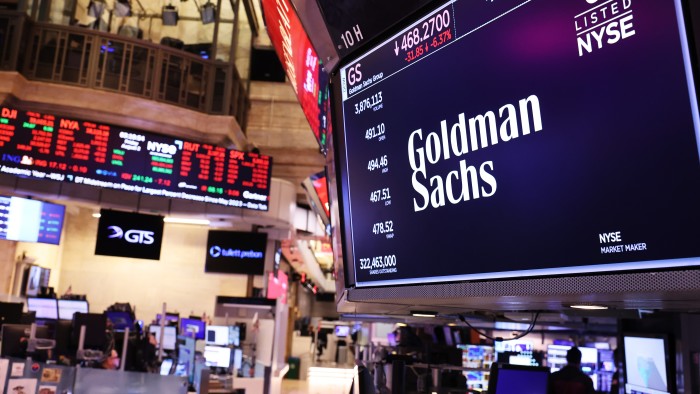Unlock the Editor’s Digest for free
Roula Khalaf, Editor of the FT, selects her favourite stories in this weekly newsletter.
Goldman Sachs stood to lose just $300mn in an economic shock under the Federal Reserve’s stress test scenario this year, vastly less than the $18bn forecast a year earlier — and a big reason for the bank’s outsized shareholder payouts.
The sharp drop is a reflection of Goldman’s effort in recent years to reduce risk-taking, which requires the bank to set aside more capital to guard against volatility. But it also reflects technical changes to the Fed’s test that made it easier for Wall Street’s biggest banks. This led to a flood of dividend increases and share buybacks for investors announced on Tuesday.
Several banks benefited from the easier test but none more so than Goldman, which said it would raise its dividend by 33 per cent to $4 per share. The lower estimated losses helped reduce its capital requirement to 10.9 per cent of assets, from 13.6 per cent previously, its lowest level since the current Fed regime was introduced in 2020.
“Goldman was definitely the clear winner,” said Barclays banking analyst Jason Goldberg. The Fed declined comment.
Goldman and the other large US banks are subject to annual stress tests by the Fed to gauge their ability to withstand market shocks. This year the Fed stress tested how banks would perform if the economy declined 7.8 per cent in a year, unemployment rose to 10 per cent, coupled with home prices falling 33 per cent and commercial property prices dropping 30 per cent.
A critical change to the Fed’s test of particular benefit to Goldman was the exclusion of private equity investments from its market shock scenario, an area where Goldman has more direct exposure than its peers.
The Fed also said it adjusted its models to give greater weight to gains and losses from market hedging. The Fed cited “atypical client behaviour” at certain banks in the run-up to the 2024 US election as a factor in improved results on trading loss scenarios — language that was also interpreted to include Goldman.
“This atypical customer behaviour, so that’s pre-election trading, and the hedging, where the Fed is assessing and valuing hedges differently, is a help,” said Betsy Graseck, global head of banking research at Morgan Stanley.
But Goldman’s projected trading losses were still far below rivals — Morgan Stanley was shown to have $7bn in losses while JPMorgan faced $10.2bn. Morgan Stanley’s capital requirement in past years tracked closely to Goldman’s, and large deposit-taking banks such as JPMorgan Chase and Citi typically had even lower requirements.
For years, US banks have complained that the models the Fed uses to calculate the requirements are opaque, often to their detriment. Frustrations boiled over last year when one of the main industry lobby groups filed a lawsuit against the Fed in an effort to make the process more transparent and the results less volatile.
The Fed has said it is aiming to improve the transparency of the stress test process. Analysts said that without more disclosures from the Fed, there was no way of knowing why the discrepancy was so wide.
“Goldman Sachs could have put on more hedging derivative strategies to protect themselves in a stressful environment, which of course is what they’re testing for, than your peers,” said RBC research analyst Gerard Cassidy. “That certainly could have been the case, but we don’t have transparency to truly say.”

The stress tests are part of a group of bank rules imposed since the 2008 financial crisis used by the Fed to determine the minimum level of capital banks must have relative to their assets. Capital absorbs losses, but banks prefer to have lower requirements so they have more flexibility.
Every 10 basis points of decline in Goldman’s requirement frees up almost $700mn of capital that could to be used to fund its business or be returned to shareholders, according to calculations from Barclays’ Goldberg.
Part of Goldman chief executive David Solomon’s priorities running the bank has been to make its business more durable, including a move to pare back its private equity investments that it holds on its own balance sheet, and instead focus on managing money for outside investors.
Solomon said on Tuesday the stress test results were “a reflection of the work we have done over the years to reduce our capital intensity”.
Read the full article here




